Cool Pic Archive Pages
| 1 |
2 | 3 |
4 | 5
| 6 | 7
| 8 | 9
| 10 | 11
| 12 | 13
| 14 | 15
| 16 | 17
| 18 | 19
| 20 | 21
| 22 | 23
| 24 | 25
| 26 | 27
| 28 | 29
| 30 |
These images have been chosen for their uniqueness. Subject matter ranges from
historic events, to really cool phenomena in science and engineering, to relevant
place, to ingenious contraptions, to interesting products (which now has its own
dedicated Featured Product
category).
Beginning in the middle of the 1930s, engineering labs in the U.S. and Europe
were experimenting with radar systems. Early radars did not have the slick plan
position indicator (PPI) displays that modern systems use for plotting target movement
for indication of azimuth (direction) and range (distance). Instead, oscilloscopes
showed radar returns as amplitude blips along a time base that represented range.
Azimuth was determined by where the operator pointed the antenna (rotating versions
came later). Since radar cross section stealth technology had not been invented
yet, the amplitude of the signal was useful a measure of the size of the target.
Prior to the invention of radar (RAdio Detection And Ranging), other means were
needed to detect approaching aircraft during times of war. Human spotters were often
posted in open fields, tall building rooftops, shorelines, and hills in order to
provide a measure of warning against approaching enemy aircraft (acoustic defense).
Effectiveness was dependent on many parameters like quality of eyesight, hearing
and alertness of the observers, atmosphere transparency (visibility), light level,
aircraft size, configuration, color and noise level, etc. Even under ideal conditions
detected aircraft would be no more than a few minutes away from the observer, so
that did not leave a lot of time to prepare a response. Observer networks were set
up as far in advance of key targets as possible through a radio relay network, but
it left a lot to be desired.
That's where the strange, often Dr. Seuss-looking listening devices shown below
were designed and employed to aid the observers. These photos are all over the Internet,
so I do not know their origins. I will be glad to credit the true owner(s) if contacted,
and will provide a hyperlink to the originals. Thanks to Bob D. for letting me know
about them.
|

Compliments of Dr. Seuss
|
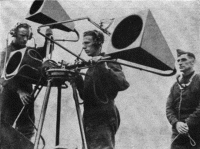
Didn't I see an ad for this in the back of Popular Science?
|

An alt-az mount - impressive!
|
|

Modified cheerleader megaphones
|
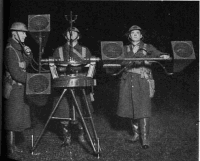
Also useful for listening to avian mating
rituals
|
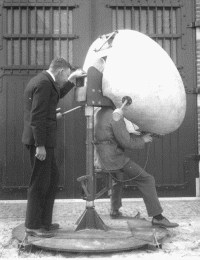
OK, this one has to be a joke
|
|
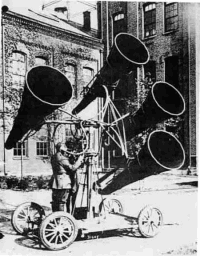
Dr. Seuss again
|

This concept was later used as an inspiration
for the Ferris wheel
|
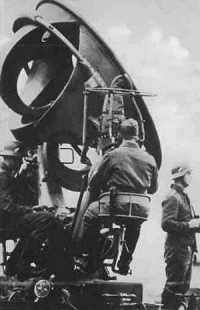
Achtung! Wir hören können alles, was
sie sagen.
|
The douglas-self.com
web page link was sent to me after posting these pictures. It has more information
on these pictures. You'll probably enjoy perusing some of the other topics he has
as well.
Here is a page on early
radar development.
See the
Homemade Plane Detector article from the May 1942 Popular Science magazine.
Posted March 29, 2019
|

















